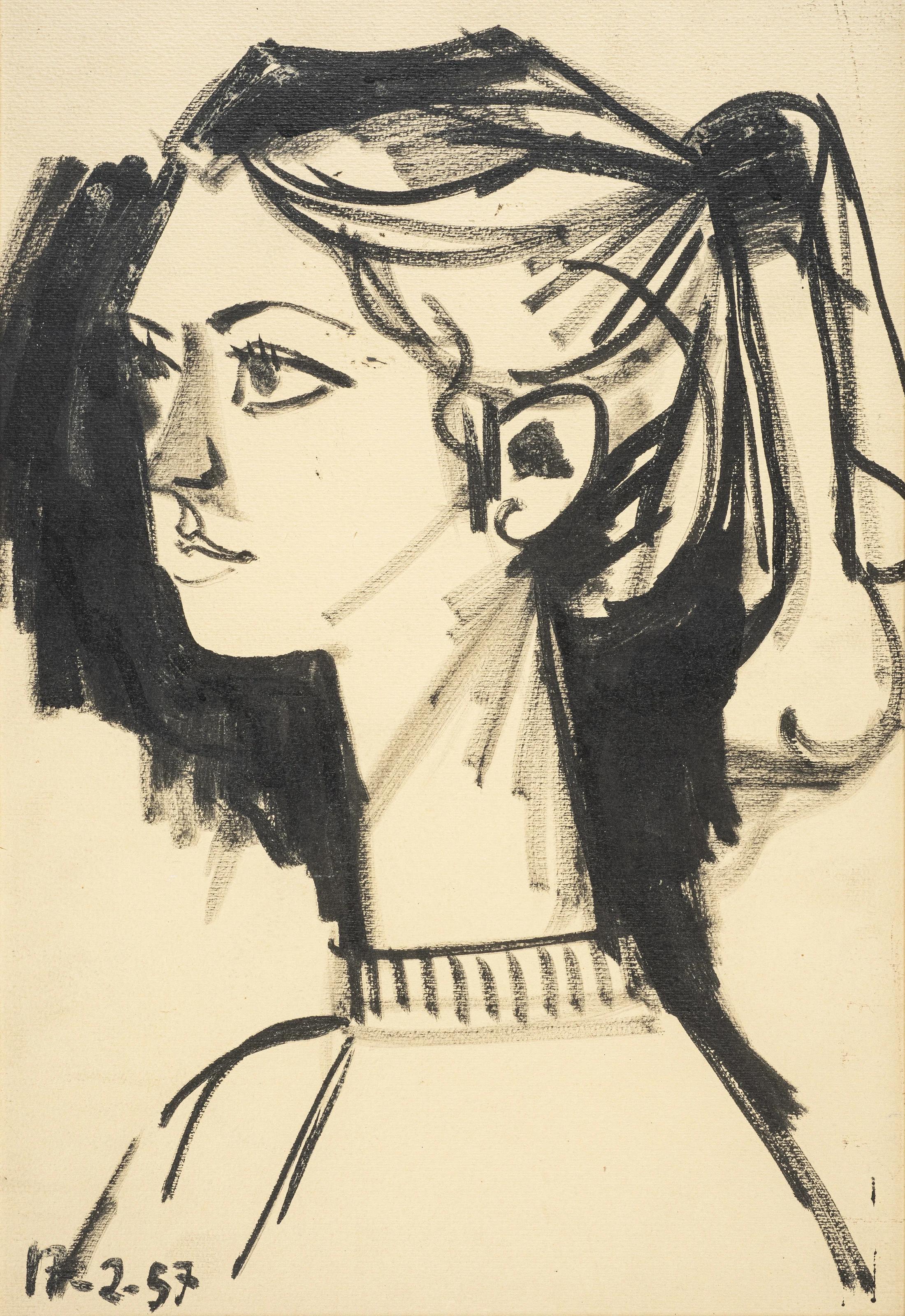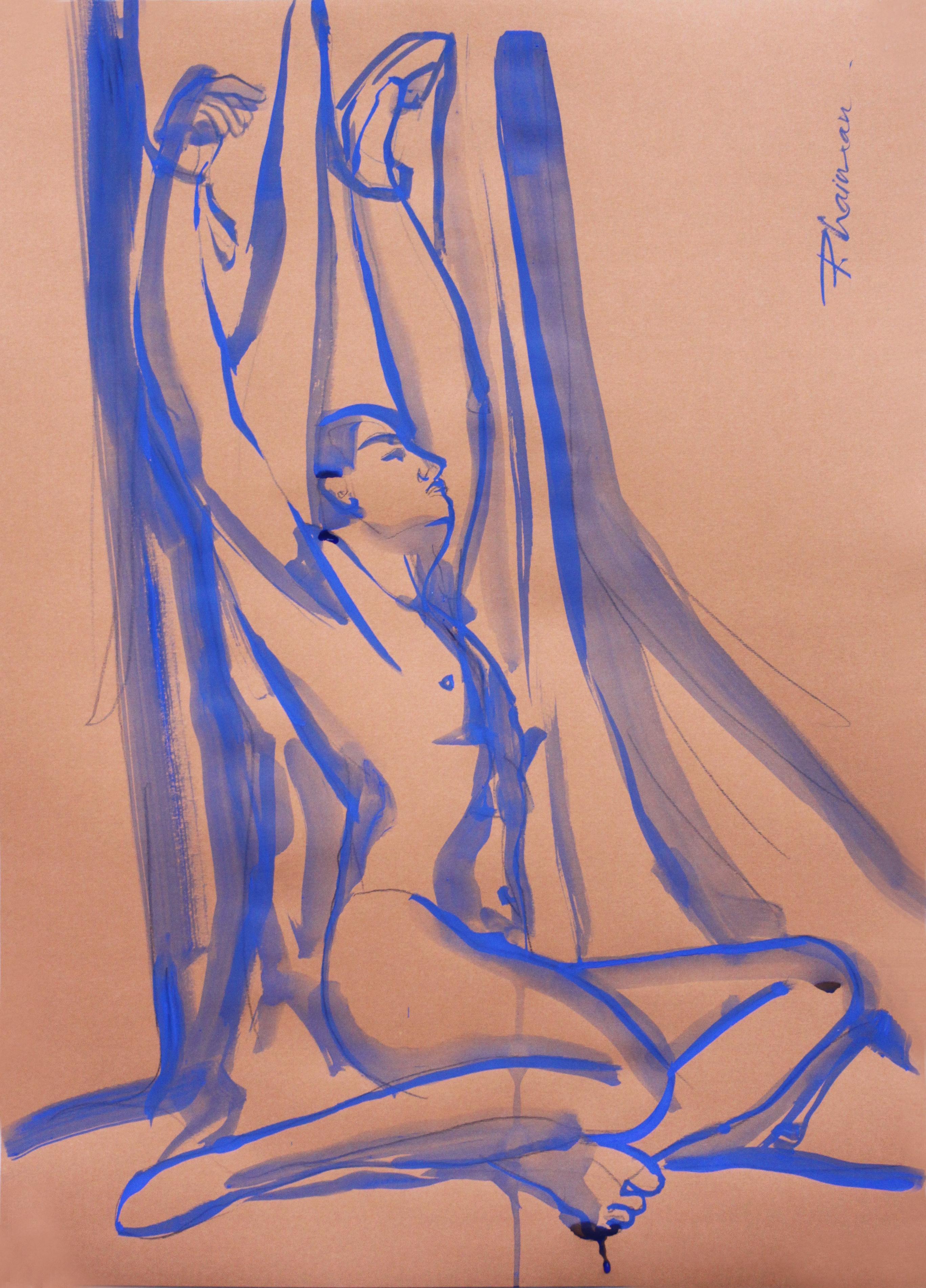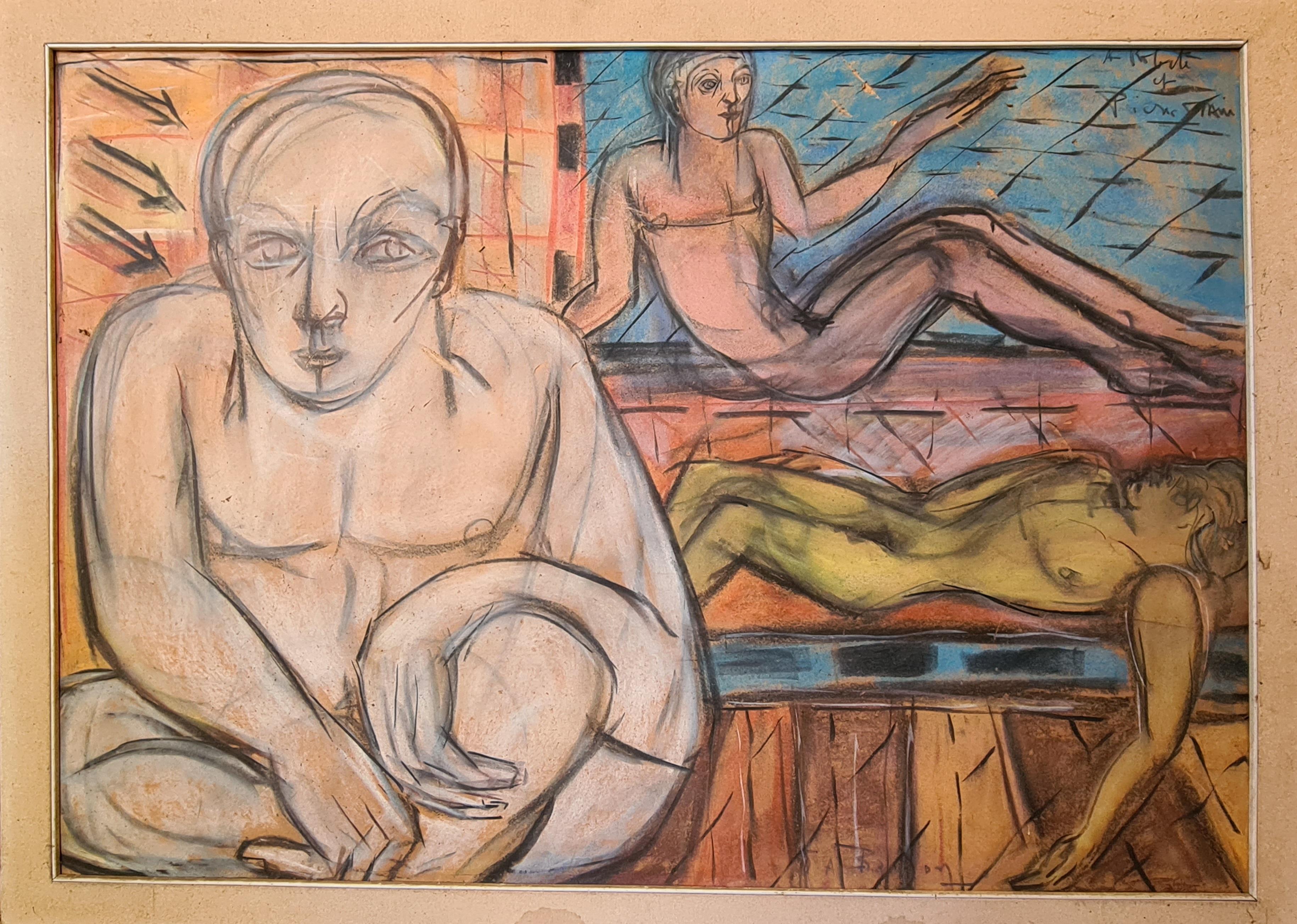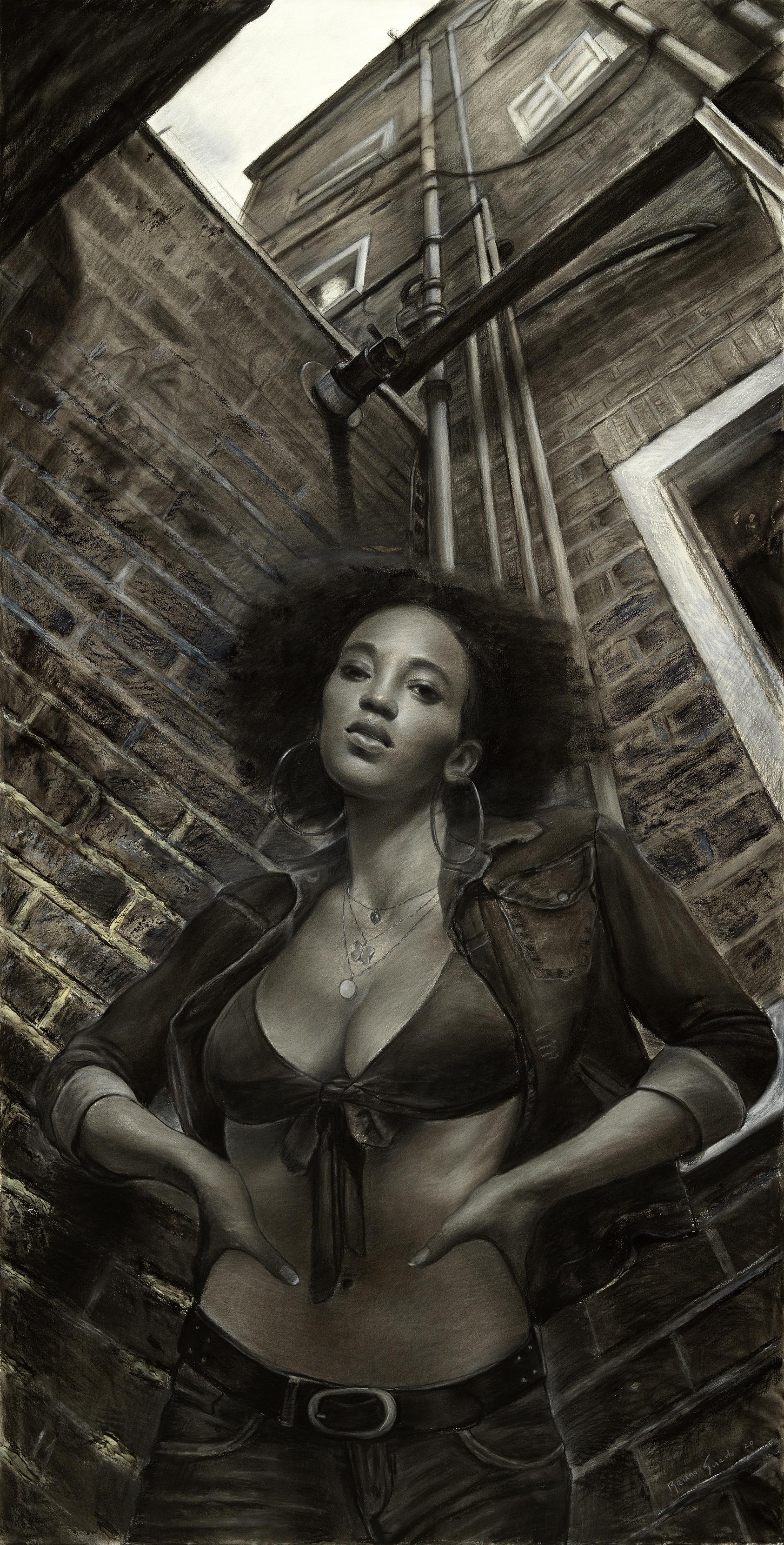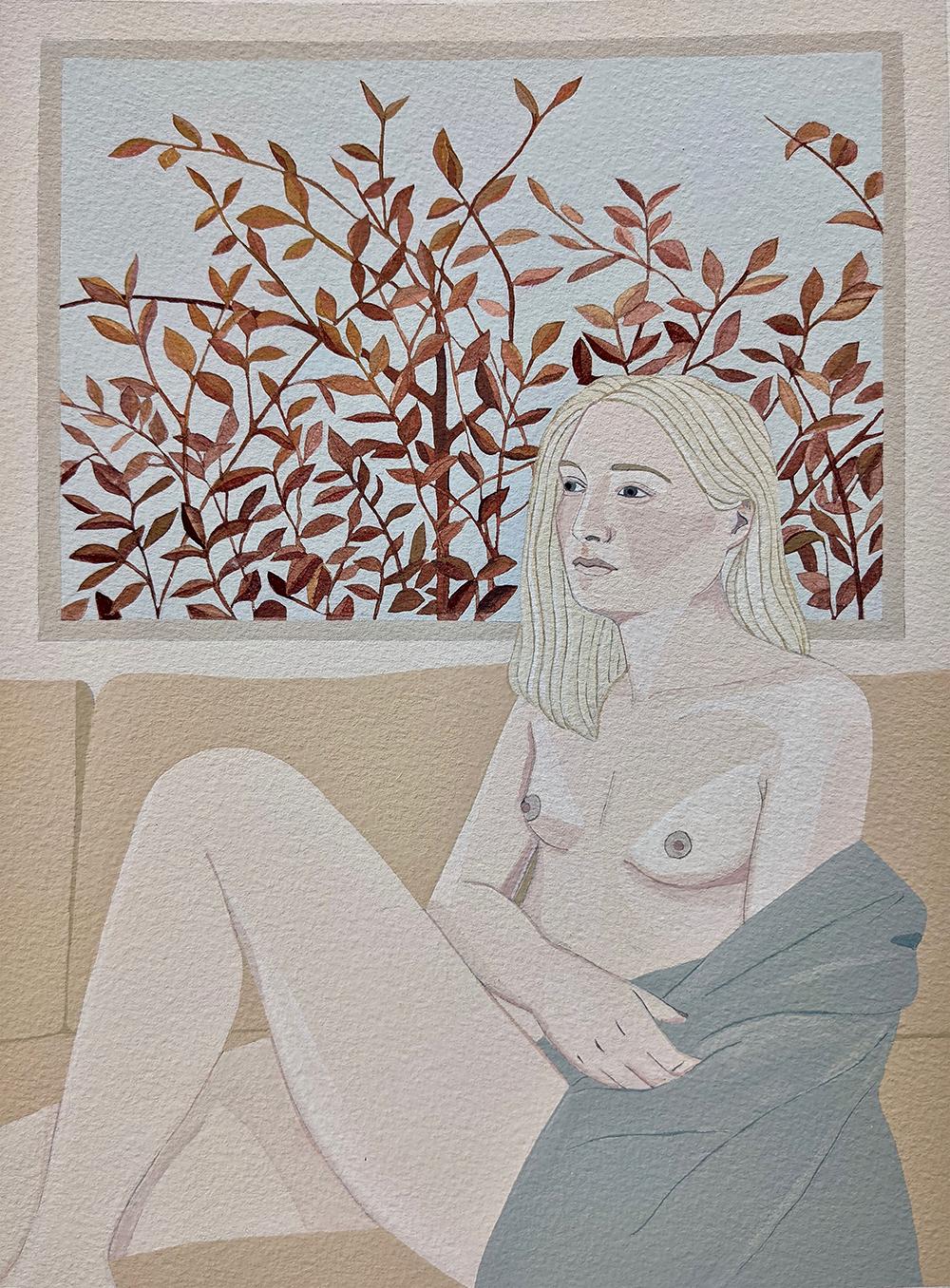Items Similar to "Nude Lady" Pencil on Paper 20" x 12" inch (1954) by Salah Abdel Kerim
Want more images or videos?
Request additional images or videos from the seller
1 of 5
Salah Abdel Kerim"Nude Lady" Pencil on Paper 20" x 12" inch (1954) by Salah Abdel Kerim 1954
1954
About the Item
"Nude Lady" Pencil on Paper 20" x 12" inch (1954) by Salah Abdel Kerim
Born in Fayoum to a big family of 5 brothers and sisters. In 1938 he meets the famous painter Hussein Bikar and he becomes his student in the Faculty of Arts in Qena. He remained much attached to his professor all through his life. In 1940 he meets Hussein Youssef Amin and the Group of Contemporary Art at the secondary school of Farouk First in Abasya district in Cairo when he was introduced to surrealism for the first time. In 1943 he becomes a student at the Faculty of Fine Arts and graduates with excellence and honors in 1947. In 1948 he becomes an assistant to the interior decoration section at the FFA. He is then sent to a mission in Paris in 1952 and he becomes a student to Paul Colin and A.Marie Cassandre for publicity and theatre design. He then moves to Rome in 1956 to study cinema design. In 1957 he received the international prize in painting from San Vito Romano, Italy, and obtains his Ph.D. from Centro Sperimental di Cinemato Grafia. Back in Egypt in 1958, he is appointed professor at the FFA where he started experimenting with his masterpieces sculptures in wrote iron. In 1959 he receives the first prize for sculpture at the Biennale of Alexandria. In the same year, he receives from the Biennale of Saint Paolo, Brazil honorary merit for his sculpture "The Fish". In 1960 he receives the award of the Guggenheim National section for his painting "Fighting Roosters". In 1961, Rene Huyghe included his sculpture "Cry of the Beast" in his book "Art and Man" together with the great P.Picasso and Muller under the title of "The energy of Form". In 1963, he receives the same sculpture honorary merit for the same sculpture from the 7th Biennale of San Paolo.
- Creator:Salah Abdel Kerim (1925 - 1988)
- Creation Year:1954
- Dimensions:Height: 20 in (50.8 cm)Width: 12 in (30.48 cm)
- Medium:
- Movement & Style:
- Period:
- Condition:
- Gallery Location:Culver City, CA
- Reference Number:1stDibs: LU1085112660892
About the Seller
4.7
Gold Seller
These expertly vetted sellers are highly rated and consistently exceed customer expectations.
Established in 2016
1stDibs seller since 2018
352 sales on 1stDibs
Typical response time: <1 hour
- ShippingRetrieving quote...Ships From: Cairo, Egypt
- Return PolicyA return for this item may be initiated within 7 days of delivery.
More From This SellerView All
- "Portrait of Italian Woman" Pencil on Paper 20" x 12" inch by Salah Abdel KerimBy Salah Abdel KerimLocated in Culver City, CA"Portrait of Italian Woman" Pencil on Paper 20" x 12" inch by Salah Abdel Kerim Born in Fayoum to a big family of 5 brothers and sisters. In 1938 he meets the famous painter Hussein Bikar and he becomes his student in the Faculty of Arts in Qena. He remained much attached to his professor all through his life. In 1940 he meets Hussein Youssef Amin and the Group of Contemporary Art at the secondary school of Farouk First in Abasya district in Cairo when he was introduced to surrealism for the first time. In 1943 he becomes a student at the Faculty of Fine Arts and graduates with excellence and honors in 1947. In 1948 he becomes an assistant to the interior decoration section at the FFA. He is then sent to a mission in Paris in 1952 and he becomes a student to Paul Colin and A.Marie Cassandre for publicity and theatre design. He then moves to Rome in 1956 to study cinema design. In 1957 he received the international prize in painting from San Vito Romano, Italy, and obtains his Ph.D. from Centro Sperimental di Cinemato Grafia. Back in Egypt in 1958, he is appointed professor at the FFA where he started experimenting with his masterpieces sculptures in wrote iron...Category
20th Century Contemporary Nude Drawings and Watercolors
MaterialsPaper, Pencil
- "Bathing Nude I" Watercolor Painting 24" x 17" inch (1959) by Kawkab YoussefLocated in Culver City, CA"Bathing Nude I" Watercolor Painting 24" x 17" inch (1959) by Kawkab Youssef Signed and dated 1959 A short history of Kawkab Youssef El-Assal: With ...Category
20th Century Post-War Nude Drawings and Watercolors
MaterialsWatercolor, Paper
- "Bathing Nude II" Watercolor Painting 24" x 17" inch (1959) by Kawkab YoussefLocated in Culver City, CA"Bathing Nude II" Watercolor Painting 24" x 17" inch (1959) by Kawkab Youssef Signed and dated 1959 A short history of Kawkab Youssef El-Assal: With...Category
20th Century Post-War Nude Drawings and Watercolors
MaterialsPaper, Watercolor
- "Airness" (FRAMED) Pencil Drawing 22" x 19" inch by Antonio PelayoLocated in Culver City, CA"Airness" (FRAMED) Pencil Drawing 22" x 19" inch by Antonio Pelayo Medium: Pencil on Paper Artist Antonio Pelayo, born in Glendale, California, and yet raised for most of his child...Category
21st Century and Contemporary Contemporary Figurative Drawings and Water...
MaterialsPencil, Paper
- "Untitled 29" (FRAMED) Pencil Drawing 21" x 18" inch by Antonio PelayoLocated in Culver City, CA"Untitled 29" (FRAMED) Pencil Drawing 21" x 18" inch by Antonio Pelayo Size unframed: 15.5" x 13.5" inch Medium: Pencil on Paper Artist Antonio Pelayo, born in Glendale, California...Category
21st Century and Contemporary Contemporary Figurative Drawings and Water...
MaterialsPaper, Pencil
- "50" (FRAMED) Pencil Drawing 17" x 15" inch by Antonio PelayoLocated in Culver City, CA"50" (FRAMED) Pencil Drawing 17" x 15" inch by Antonio Pelayo Medium: Pencil on Paper Artist Antonio Pelayo, born in Glendale, California, and yet raised for most of his childhood ...Category
21st Century and Contemporary Contemporary Figurative Drawings and Water...
MaterialsPaper, Pencil
You May Also Like
- An August Resaissance / 2018 - framed nudeBy Kim FrohsinLocated in Burlingame, CABlue nude is swirling abstracted water figurative painting from Kim Frohsin's "Emergence" series from 2018. Frohsin, third generation Bay Area Figurative artist—from the movement tha...Category
21st Century and Contemporary Contemporary Figurative Paintings
MaterialsInk, Mixed Media, Acrylic, Tempera, Gouache, Color Pencil
- In Chains - Male Nude original art by Paula CraioveanuBy Paula CraioveanuLocated in Forest Hills, NY"In Chains" Male Nude inspired by St Sebastian. Ultramarine tempera on colored paper. Size 27.5x19.5in / 70x50cm . See the other nudes from the same series. Shipped rolled in a...Category
2010s Contemporary Nude Drawings and Watercolors
MaterialsTempera, Carbon Pencil
- Futurist, Novecento Italiano, Mid Century Italian Painting, Figures at the BathsBy Anselmo BucciLocated in Cotignac, FRMid 20th Century Italian Futurist, Novecento Italiano, work on paper, signed bottom right and with dedication top right (see photos). The subject is bathers enjoying the delights of a spa and sauna with colourful tiling to the background. The classical figures languorously positioned in repose but the central 'white' figure in stark contrast. The play on colours gives the work a vibrancy. The drawing is possibly a preparatory sketch for a larger work or mural. A vibrant, exciting and colourful work incorporating the styles of Futurism and the Novecento Italiano movement and with the influences or artists such as Anselmo Bucci, Adami, Jean Helion, Maryan, Achille Funi and Ugo Guidi. Anselmo Bucci was born in 1887 in Fossombrone in the district of Pesaro. Even though he studied Classics, right from a tender age he showed a talent for drawing and, when his parents moved near to Florence, he was taught by the artist Francesco Salvini. In 1904 the family settled in Monza and so the boy was able to study for a year at the Accademia di Belle Arti di Brera, but he did not follow up this educational experience and in 1906 he left Italy for Paris where he came into contact with the Parisian avant-garde, met fellow Italian artists such as Severini and Modigliani, and made friends with Picasso, Utrillo and Apollinaire. In 1907 he showed a painting at the Salon, but these Parisian years were most important for his love of engraving techniques – etching and dry point that enabled him to fully develop his themes characterised by movement. On the outbreak of war in 1915 he returned to Italy and he enlisted in the same battalion as several Futurist artists such as Martinetti, Boccioni, Sant’Elia and Carlo Erba. In 1914 he won the silver medal at the Mostra dell’Incisione (Exhibition of Engravings) at Florence. In 1917 in Paris he published pictures of war scenes entitled “Croquis du Front Italien”. In 1919 he printed twelve lithographs entitled “Finis Austriae” again showing events from the war. At the end of the war he lived between Milan and Paris and he dedicated his time completely to his art with personal exhibitions, exhibiting at all the most important Italian and French shows, in Belgium, Holland and England. In 1922, he established the group “Movimento del Novecento”, (Novecento Italiano), (20th century Movement) a joint venture with the artists Sironi, Funi, Oppi, Malerba, Dudreville and Marussig. Their aim was to return to figurative art in contrast with the growing extremism of the Avant-gardists. In 1925 he worked on the illustration of the first edition of Kipling’s The Jungle Book producing eight dry point plates. In the early 30’s he lived in Bucci, Trieste, where he worked on the furnishing of the steamships for the Trieste Navigazione Libera, at the same time he continued to work on many book illustrations. During the second European war he adapted to being a war artist recording the events of the war as he had done previously. Indeed the engravings depicting battles of the Marines and the Air Force belong to this period. In 1945, following the bombing of his house in Milan, he returned to Monza to his father’s home where he remained until his death. Futurism was an Italian art movement of the early twentieth century that aimed to capture in art the dynamism and energy of the modern world. Futurism was launched by the Italian poet Filippo Tommaso Marinetti in 1909. On 20 February he published his Manifesto of Futurism on the front page of the Paris newspaper Le Figaro. Among modernist movements futurism was exceptionally vehement in its denunciation of the past. This was because in Italy the weight of past culture was felt as particularly oppressive. In the Manifesto, Marinetti asserted that ‘we will free Italy from her innumerable museums which cover her like countless cemeteries’. What the futurists proposed instead was an art that celebrated the modern world of industry and technology: We declare…a new beauty, the beauty of speed. A racing motor car…is more beautiful than the Victory of Samothrace. (A celebrated ancient Greek sculpture in the Louvre museum in Paris.) Futurist painting used elements of neo-impressionism and cubism to create compositions that expressed the idea of the dynamism, the energy and movement, of modern life. Chief artists associated with futurism were Giacomo Balla, Umberto Boccioni, Gino Severini. After the brutality of the first world war, many artists rejected the avant-garde notions of futurism and other pre-war movements, by using more traditional and reassuring approaches, a phenomenon described as the ‘return to order’. Novecento Italiano was founded by Anselmo Bucci (1887–1955), Leonardo Dudreville (1885–1975), Achille Funi, Gian Emilio Malerba (1880–1926), Pietro Marussig, Ubaldo Oppi, and Mario Sironi. Motivated by a post-war "call to order", they were brought together by Lino Pesaro, a gallery owner interested in modern art, and Margherita Sarfatti, a writer and art critic who worked on Italian dictator Benito Mussolini's newspaper, The People of Italy (Il Popolo d'Italia). Sarfatti was also Mussolini's mistress. The movement was officially launched in 1923 at an exhibition in Milan, with Mussolini as one of the speakers. The group was represented at the Venice Biennale of 1924 in a gallery of its own, with the exception of Oppi, who exhibited in a separate gallery. Oppi's defection caused him to be ejected from the group, which subsequently split and was reformed. The new Novecento Italiano staged its first group exhibition in Milan in 1926. Several of the artists were war veterans; Sarfatti had lost a son in the war. The group wished to take on the Italian establishment and create an art associated with the rhetoric of fascism. The artists supported the fascist regime and their work became associated with the state propaganda department, although Mussolini reprimanded Sarfatti for using his name and the name of fascism to promote Novecento. The name of the movement (which means 1900s) was a deliberate reference to great periods of Italian art in the past, the Quattrocento and Cinquecento (1400s and 1500s). The group rejected European avant garde art and wished to revive the tradition of large format history painting in the classical manner. It lacked a precise artistic programme and included artists of different styles and temperament, for example, Carrà and Marini. It aimed to promote a renewed yet traditional Italian art. Sironi said, “if we look at the painters of the second half of the 19th century, we find that only the revolutionary were great and that the greatest were the most revolutionary”; the artists of Novecento Italiano “would not imitate the world created by God but would be inspired by it”. Despite official patronage, Novecento art did not always have an easy ride in Fascist Italy. Mussolini was personally uninterested in art and divided official support among various groups so as to keep artists on the side of the regime. Opening the exhibition of Novecento art in 1923 he declared that “it is far from my idea to encourage anything like a state art. Art belongs to the domain of the individual. The state has only one duty: not to undermine art, to provide humane conditions for artists, to encourage them from the artistic and national point of view." The movement was in competition with other pro-Fascist movements, especially Futurism and the regionalist Strapaese movement. Novecento Italiano also met outright opposition. Achille Starace, the General Secretary of the Fascist Party, attacked it in the Fascist daily press and there was virulent criticism of its “un-Italian" qualities by artists and critics. In the 1930s, a group of professors and students at the Accademia di Brera established an opposition group to Novecento Italiano. Among them was the director of the academy Aldo Carpi, and students Afro, Aldo Badoli, Aldo Bergolli, Renato Birolli, Bruno Cassinari, Cherchi, Alfredo Chighine, Grosso, Renato Guttuso, Dino Lanaro, Giuseppe Migneco, Mantica, Ennio Morlotti, Aligi Sassu, Ernesto Treccani, Italo Valenti, and Emilio Vedova (and later Giuseppe Ajmone...Category
Mid-20th Century Futurist Figurative Paintings
MaterialsCrayon, Pastel, Pencil, Paper
- The Gangway of Justice, Woman Backed into a Corner, Life-Sized Charcoal on PaperBy Bruno SurdoLocated in Chicago, ILDuring the Capone era, dark and narrow passageways became escape routes for those evading the law or other gang members, thus the Chicago term “gangway” was born. Even the police were afraid to enter gangways alone. Bruno has taken that information and created this very provocative piece entitled "The Gangway of Justice" where we see a beautiful black woman...Category
21st Century and Contemporary Contemporary Figurative Paintings
MaterialsCharcoal, Panel, Archival Paper
- Under the Red Leaves gouache painting of female nude, pastel colors, white frameBy Ellen Von WiegandLocated in Dallas, TXBeautiful original gouache paintings on Arches watercolour paper by Ellen Von Wiegand are framed in white, all archival materials, and ready to hang. "Under the Red Leaves" is a gorg...Category
2010s Contemporary Figurative Paintings
MaterialsGouache, Archival Paper
- The Sun Dazzled the House with Light, gouache painting of female nude on yellowBy Ellen Von WiegandLocated in Dallas, TXBeautiful original gouache paintings on Arches watercolour paper by Ellen Von Wiegand are float mounted and framed in white, all archival materials, and ready to hang. "The Sun Dazzl...Category
2010s Contemporary Figurative Paintings
MaterialsGouache, Archival Paper
Recently Viewed
View AllMore Ways To Browse
Vintage School Pencils
Vintage Paper Theatre
Egyptian Saints
Vintage Rooster Drawing
Vintage Ffa
Malcolm Pasley
Emili Jewelry
Edmund Chin
Fernando Garcia Ponce
Toll Couches
Thomas Wilmer Dewing
Rockford Secretary
Ashley Herald
Marin Marie
Line Drawing Nude Woman
Antique Nude Male Paintings
Male Nude Original Painting
Male Nude Original Drawing
